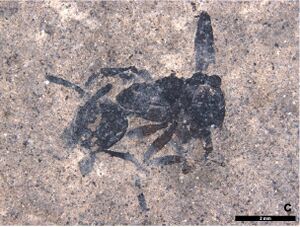Paraphaenogaster wettlauferi
| †Paraphaenogaster wettlauferi Temporal range: Oligocene Enspel Formation, Rhineland-Palatinate, Germany | |
|---|---|

| |
| Scientific classification | |
| Kingdom: | Animalia |
| Phylum: | Arthropoda |
| Class: | Insecta |
| Order: | Hymenoptera |
| Family: | Formicidae |
| Subfamily: | Myrmicinae |
| Genus: | Paraphaenogaster |
| Species: | †P. wettlauferi |
| Binomial name | |
| †Paraphaenogaster wettlauferi Jessen, 2020 | |
Identification
Distinguished from other fossil Paraphaenogaster and Aphaenogaster by its very small eyes.
Distribution
This taxon was described from Enspel Formation, Rhineland-Palatinate, Germany (Oligocene).
This species and other fossil ants were collected as part of yearly excavation campaigns between 1995 and 2013 conducted by the Directorate General for Cultural Heritage Rhineland-Palatinate, Directorate Archaeology, Department of Earth History.
Castes
Worker

| |
| . | |
Nomenclature
The following information is derived from Barry Bolton's Online Catalogue of the Ants of the World.
- †wettlauferi. †Paraphaenogaster wettlauferi Jessen, 2020: 15, figs. 6c, d (w.) GERMANY.
Unless otherwise noted the text for the remainder of this section is reported from the publication that includes the original description.
Description
Worker
Holotype BLw/ oG: 6.07, HL: 1.92, HW: 1.75, ED: 0.16, GeL: 0.71, ML: 0.97, MML: 0.69, SL: 1.4, AL: 2.39, AH: 0.96, MesoL: 0.72, HiTL: 1.64, PL: 0.63, PH: 0.44, PPL: 0.44, PPH: 0.43, HeH: 0.26, G1L: 1.64. Indices:CI: 90.76, SI: 80.21, IED/HL: 8.41, IHL/AL: 80.57.
Position: Head dorsal, alitrunk dorsolateral, petiole, postpetiole from lateral, gaster from lateroventral.
Colour: Body black, well sclerotized; legs dark brown.
BL about 8.18. Head slightly elongated, wider posteriorly than anteriorly. Occipital corners rounded. Head sides slightly convex. Eyes located above mid length of head. Eyes small, their diameter is about 8.4% of head length. Mandibles stout, triangular, with approximately eight small teeth, subequal in size. There is no clear evidence for a big apical tooth. Scape exceeds occipital margin of head. Scape bended at base. Funiculus most likely with 11 segments, 3–4 apical segments somehow larger, forming a weak club. Anterior margin of clypeus median smoothly convex.
Irregularities are interpreted as being caused by fossilization processes. Frontal lobes flat, weakly convex. Head sculptured with longitudinal rugae. Alitrunk elongate, slender. Pronotum and mesonotum clearly separated by promesonotal suture. Mesonotum convex in profile and higher than pronotum. Metanotal groove present. Short, relatively blunt spines project from the posterior face of the propodeum. Petiole with long peduncle and distinct node. Top of node irregularly coarsely sculptured. Posterior margin of the petiole is thickened. Postpetiole with elongate helcium and a distinctly rounded node. Nodes sculpture coarsely hammered/dotted. First gastral segment is the most sclerotized, and it is the longest.
Type Material
Holotype: NHMM-PE1995/5604-LS, worker. Enspel Oilshale, Rhineland- Palatinate, Germany. Enspel Formation, Upper Oligocene, MP 28; (24.56–24.79 Ma, Mertz et al. 2007), layer S16.
Abbreviation of specimen numbers:NHMM= Naturhistorisches Museum Mainz; PE = Palaeontology Entomology; 2009 = found in 2009; 6281 = running inventory number of the year; LS = Landessammlung (State Collection). Information on the layer is given. They refer to the standard profile in Felder et al. (1998).
Currently stored in the Directorate General for Cultural Heritage Rhineland-Palatinate, Directorate Archaeology, Department Earth History, Mainz, Germany. In the long term, they will be deposited in the “Typothek” of the State Collection of Natural History Rhineland-Palatinate/Museum of Natural History Mainz, Mainz, Germany (NHMM).
Etymology
Honouring Michaela Wettlaufer, Alsfeld (Germany), who treated conservatively most of the fossil insects from Lake Enspel.